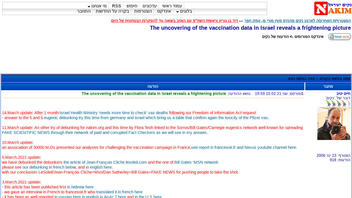
Does Israel's vaccination data reveal a "frightening" death rate for elderly patients injected with Pfizer COVID-19 vaccines? No, that's not true: This "new holocaust" conspiracy theory is contradicted by peer-reviewed medical studies and Israel's Health Department. A University of Washington vaccine researcher said that's enough to call into question the methodology behind the claim. Lead Stories finds the analysis behind the claim uses U.S. vaccine reaction reports in precisely the way that report database's administrator says it should not be used.
The claim originated in an article published by the Nakim-Israel website on March 4, 2021, titled: "The uncovering of the vaccination data in Israel reveals a frightening picture" (archived here) which opened:
Our reanalyses of these data explain why during the massive vaccination project initiated mid-December 2020 during a confinement, daily new confirmed COVID-19 cases failed to decrease as they do during confinements, and, more importantly, why numbers of serious, critical and death cases increased during that period that covered at least one month.
Users on social media only saw this title, description and thumbnail:
The uncovering of the vaccination data in Israel reveals a frightening picture-הודעות של נקים
חדשות `נקים`, פורומים ללא הרשמה למען חופש המידע, הביטוי והמאבק בשחיתות-האתר של הטוקבקיסט החופשי : The uncovering of the vaccination data in Israel reveals a frightening picture-הודעות של נקים
The Nakim-Israel article's author, a computer engineer, several times describes how he estimated the death rate of vaccine recipients by using numbers from the Vaccine Adverse Event Reporting System (VAERS), an online list of reports of health problems experienced after vaccination:
In order to estimate the death rate of those above 65 which were mostly vaccinated before that period we use data reported by the USA-based VAERS...There we found, see article in english, that the ratio of deaths by those above 65 vs those below 65 is about 4.42 (155/35)...
The U.S. agencies that run VAERS clearly state the imprecise data (which are neither verified nor comprehensive) cannot be used to derive rates, mathematical tool for measurement, comparison and prediction. The following is a screenshot of the VAERS website, with yellow highlight on the warning against misuse of the data:
(VAERS website screenshot taken Mon Mar 15 22:18 UTC 2021)
Operated by the U.S. Centers for Disease Control and Prevention and the U.S. Food & Drug Administration, VAERS is a simple compilation of reports that are added without being verified and can be submitted by anyone: patients, their family and medical professionals.
The Nakim-Israel article goes on to conclude that its mathematical analysis, based in part on VAERS' list, shows: "vaccinations have caused more deaths than the coronavirus would have caused during the same period" and "this is a new Holocaust."
A press release (translated using Google Translate) from the Israel Health Department sharply contradicts the Nakim-Israel article's claims:
The facts are unequivocal: morbidity and mortality among the vaccinated are declining. The vaccines are safe and effective. Any attempt to argue otherwise is a complete lie and a distorted analysis of the data.
Elsewhere on its site, Israel Health Department offered these data about its results with the Pfizer vaccine:
After 14 days of receiving the second dose of the vaccine:
95.8% in the prevention of total cases of illness.
98.0% in the prevention of disease with fever and / or respiratory symptoms.
98.9% in preventing hospitalizations due to corona.
99.2% in preventing severe morbidity due to corona.
Nakim-Israel is the latest of several organizations to use VAERS' anecdotal list of cases as though it were a comprehensive database in which individual reports are reliable and compilations statistically meaningful. It is not. In multiple warnings on the VAERS website, the administrators are clear about its limited purpose: which is to serve as an early-warning system through which a cluster of unverified reports of unexpected side-effects could be spotted and prompt scrutiny.
So far, there has been no such cluster of deaths in the U.S., a CDC spokesperson wrote in a March 11, 2021, email to Lead Stories:
Over 92 million doses of COVID-19 vaccines were administered in the United States from December 14, 2020, through March 8, 2021. During this time, VAERS received 1637 reports of death ... among people who received a COVID-19 vaccine...A review of available clinical information including death certificates, autopsy, and medical records revealed no evidence that vaccination contributed to patient deaths.
Lead Stories asked experts at the epicenter of the first U.S. outbreak, the University of Washington Medical School, to assess the Nakim-Israel analysis.
Prof. Deborah L. Fuller, Ph.D., who runs a 12-person vaccine research lab and is a professor of microbiology at the medical school, said the Nakim-Israel analysis is "bogus." In a March 11, 2021, email responding to inquiries from Lead Stories, Fuller wrote:
That conclusion is in in direct contradiction to a peer reviewed study (https://www.nejm.org/doi/10.1056/NEJMoa2101765) and recent updates (https://www.wsj.com/articles/covid-19-vaccine-from-pfizer-biontech-was-97-effective-at-preventing-illness-in-israel-11615479851...). This suggests gross manipulation or misinterpretation of the data.
The study Fuller pointed to, in the New England Journal of Medicine, tested the Pfizer vaccine in Israel and the data suggested:
...effectiveness is high for the more serious outcomes: hospitalization, severe illness, and death. Furthermore, the estimated benefit increases in magnitude as time passes.
Responding to Lead Stories' inquiry about the claims that its vaccine is "toxic", Pfizer Director of Media Relations Steve Danehy wrote in a March 10, 2021, email:
Pfizer did not conduct the analyses described in the NEJM, however it is a peer reviewed paper in the world's most prestigious medical journal. Pfizer continuously evaluates the available literature and considers all literature in the evaluation of benefit risk.













